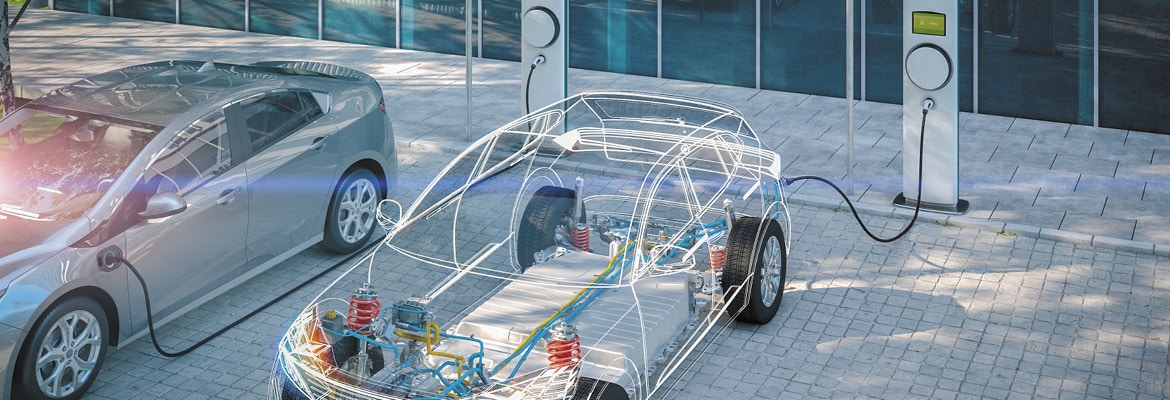Author(s)
From automakers and energy companies to car enthusiasts and everyday drivers, there is a widespread interest in electric vehicles (EVs). Electric transportation helps the planet and the economy while offering innovations in automobile technology.
2024 was a landmark year for electric vehicles, with global EV sales seeing a 25% increase. A record-breaking 1.3 million EVs were sold in the United States alone, a 7.8% increase from 2023.
2025 is shaping up to be another big year for electric vehicles with Lucid, Volvo, Mercedes Benz, RAM, and others expanding their EV lineups. More luxury and performance vehicles, SUVs, and trucks are entering the EV market, introducing a diverse selection for all types of drivers.
In this blog, we’re listing our picks for the best electric cars coming in 2025, plus a shortlist of honorable mentions that are on the horizon.
Hyundai IONIQ 9
This all-new, three-row electric SUV draws design inspiration from the Hyundai Seven concept. Sized similarly to the Hyundai Palisade and Kia EV9, it offers a lounge-like interior with six or seven-passenger configurations. It will come with a single-motor RWD and two dual-motor AWD options. Hyundai targets 335 miles of range for the single-motor version. Pricing is estimated between $62,000 and $73,000. The Hyundai IONIQ 9 is set to release in spring 2025.
Kia EV9 GT
Entering its third year, the EV9 maintains its appeal as a family-friendly, three-row EV. It features modern styling, a functional interior, and an estimated range of up to 304 miles. It can tow up to 5,000 pounds and accommodate DC fast-charging up to 230 kW. All 2026 models will include a North American Charging System port with an adapter for Combined Charging System chargers. (Learn more about charging levels and systems in our EV Charging Guide.)
The new EV9 GT boasts 501 horsepower and an adaptive suspension. The price will range from $57,000 to $80,000, with limited quantities of the vehicle becoming available in late 2025.
Lotus Eletre
Combining luxury and performance, Lotus’s first SUV, the Eletre, is a high-performance electric SUV. Lotus describes the vehicle as “The electric Hyper-SUV with racecar DNA”. Despite its weight, it delivers strong acceleration with at least 603 horsepower, aiming to compete with EVs like the Audi e-tron and BMW iX.
The Eletre is packed with cutting-edge technology like deployable spoilers for enhanced aerodynamics and a driver-focused cockpit with intelligent connectivity features. The Eletre will be available in three configurations: the base model, the top-spec R model, and the carbon model. Depending on the model, the Eletre can cover 304 to 373 miles per full battery charge, with a range of 603 to 905. Price ranges will start at $107,000 to $299,000 depending on the model.
Lucid Gravity
The 2025 Gravity SUV features two electric motors providing all-wheel drive and a maximum range of 450 miles per charge. Both two- and three-row versions are available with six- and seven-passenger seating options.
With its spacious cabin and luxurious interior, the Gravity sits among the best EVs for long-distance drives. The Gravity will be available in Touring and Grand Touring trims. Pricing ranges from $81,550 to $96,550
Mercedes-Benz G-Wagen Electric
The all-electric G 580 with EQ Technology (G-Class EV) retains the classic boxy styling of the gas-powered G-Class. It features four electric motors, each controlling a wheel, for a combined 579 horsepower. The Edition One model is loaded with features like AMG Line and Night packages. The 2025 model starts at $162,650
Buying an electric vehicle?
Don’t let distance keep you from purchasing the perfect EV. Buy your dream car online, then have it shipped to your door with Montway Auto Transport.
Learn more: EV 101: What to Know When Buying an Electric Car
Polestar 4
A sportier version of the Polestar 3 SUV, the Polestar 4 has a coupe-like silhouette and a digital rearview mirror instead of a rear window. It offers both 272-hp single-motor and 544-hp dual-motor powertrains, with the latter capable of 0-60 mph in an estimated 3.7 seconds. The single-motor model provides a range of 300 miles per charge. Prices range from $54,900 to $74,300.
RAM 1500 REV
The 2026 Ram 1500 REV pickup promises big range and towing capability with zero emissions. It retains a body-on-frame chassis and is styled similarly to the gas-powered Ram 1500.
It will initially be available as a crew-cab model with a short bed, and the option of two battery pack sizes, with the larger offering a range of up to 500 miles. It can tow up to 14,000 pounds, depending on the options. Pricing is estimated to start between $58,000–$85,000.
Volvo EX30
Volvo’s new entry-level electric SUV offers stylish, compact design with the company’s trademark attention to safety features and accessibility. The dual-motor version has 422-hp and is the quickest-accelerating Volvo to date. A 64.0-kWh battery pack offers up to 253 miles of driving per charge.
The interior incorporates recycled materials, a high-performance audio system, Park Pilot Assist, and practical storage solutions for convenience and comfort. The price of the 2025 Volvo EX30 starts at $46,195 and goes up to $47,895 depending on the trim and options.
EVs to watch in 2025 and beyond:
These exciting new vehicles aren’t released yet, but they’re generating buzz among enthusiasts and drivers alike. Keep an eye out for these EVs coming in the future.
Porsche 718 EV
The next generation of the Porsche 718 Cayman and Boxster sports cars are going fully electric. The 718 EV will likely offer a lightweight rear-drive base model and a dual-motor all-wheel-drive variant. The expected starting price will likely be near $80,000 or higher, releasing sometime in 2026 or later.
Land Rover Range Rover EV
The iconic Range Rover is making the leap to a new model that can function on gas, hybrid, or fully electric power. The luxury electric SUV’s range, power, and pricing details are still to be announced, but pre-orders and waitlists are open.
Chrysler Airflow
Expected in 2025, the Airflow will be Chrysler’s first battery-electric vehicle (BEV), launching the company’s plan to have an all-electric portfolio by 2028.
Safely ship your electric vehicle
If you’re buying a new EV out of state, are planning a long trip, or moving across the country and need to get your vehicle to a new location, consider a professional car shipping company.
Montway Auto Transport arranges shipment for over 250,000 vehicles a year for customers nationwide. We understand the unique specifications of electric vehicles and can ensure your EV gets relocated to its destination safely. Give our shipping advisors a call at 888-666-8929 for more information or obtain an instant EV shipping quote online.







